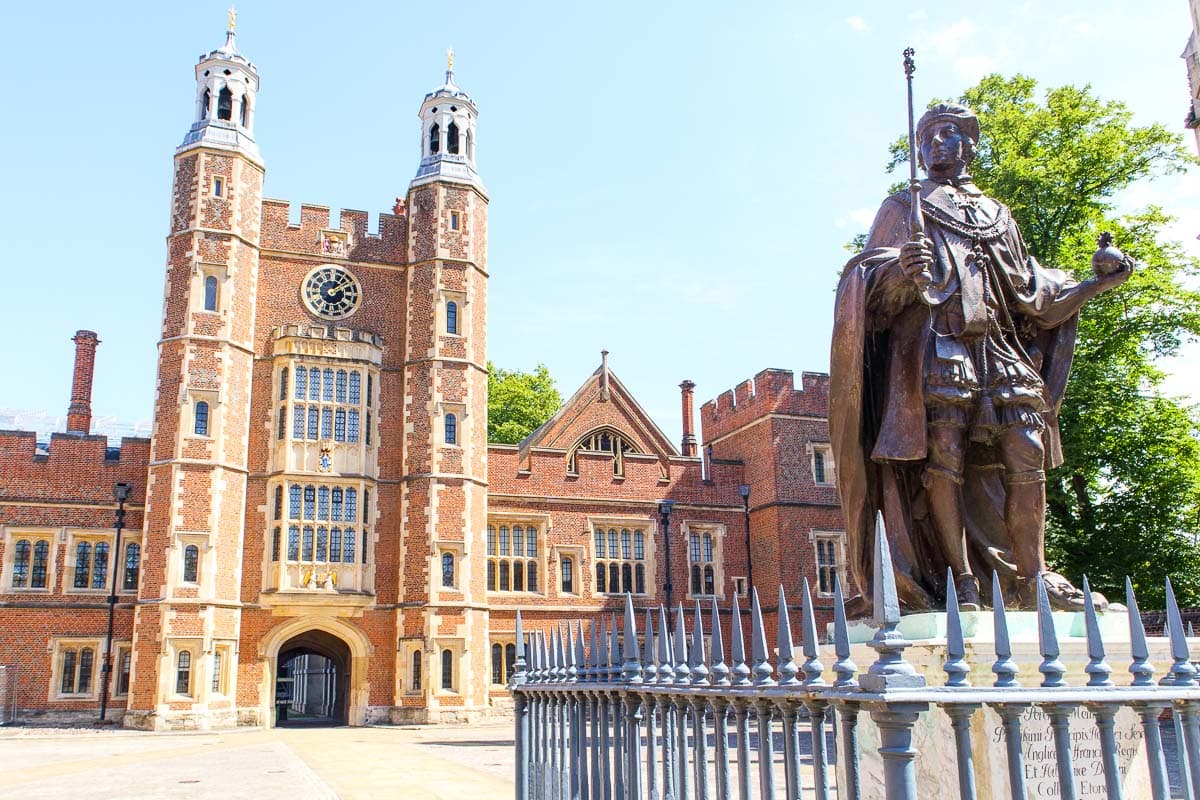From its historic roots and architecture, to uniform, entrance exams and famous students, these interesting facts about Eton College may surprise you.
We absolutely love strolling over the bridge from Windsor to Eton. While the centre of Windsor buzzes with tourists and shoppers, Eton feels quieter and more village-like. We always recommend first-time visitors to Windsor pop over to see Eton’s pretty high street lined with independent stores and characterful pubs. Plus, while you’re there, you have to go and see the amazing architecture of Eton College.
The school itself is one of the most iconic in Great Britain, with a history spanning over 500 years. Originally founded to educate boys who couldn’t afford other schooling, it has grown into one of the country’s most prestigious institutions. Over five centuries, the school has seen plenty of twists and turns, and let’s just say… there are a lot of interesting tales!
I discovered many of these facts on the Eton College Heritage Tour, which runs on Friday afternoons from May to September. The 90-minute guided visit covers a fascinating mix of history and modern school life, and includes visits to the School Yard, College Chapel, Upper School, and Lower School. Tours are very popular, so be sure to book in advance!
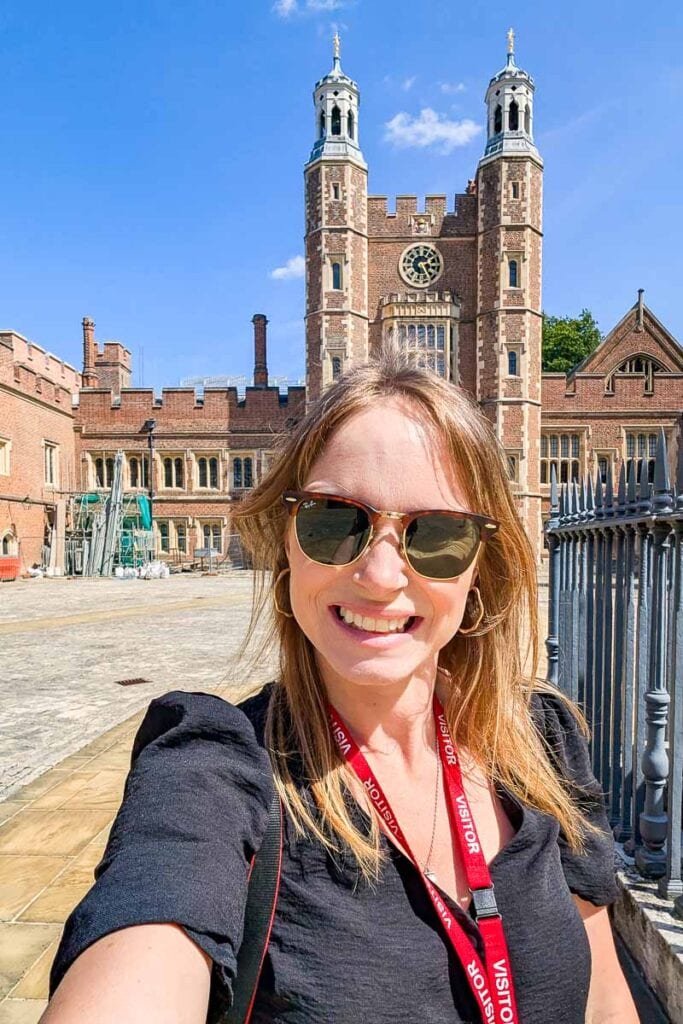
18 Interesting Facts About Eton College
Eton College was founded in 1440
King Henry VI was born in Windsor Castle in 1421. He went on to set up Eton College in 1440. Its origins were as a religious foundation, which he named “Kynge’s College of Our Ladye of Eton besyde Windesore”.
The foundation’s purpose was to provide a free education to 70 poor boys (known as King’s Scholars). However, they weren’t the only students. Others could attend (known as Oppidans), but they had to pay for their accommodation. Henry VI funded the college’s beginnings, assigning land and various benefits.
When you enter the big school yard you’ll see an impressive seven foot tall bronze statue of Henry VI by Francis Bird, completed in 1719 and erected in 1721. It’s a bold reminder of the school’s historic roots. Also, there’s a tradition that you should always walk with king nearest to your heart (i.e. so he’s on your left) so bear that in mind if you visit!
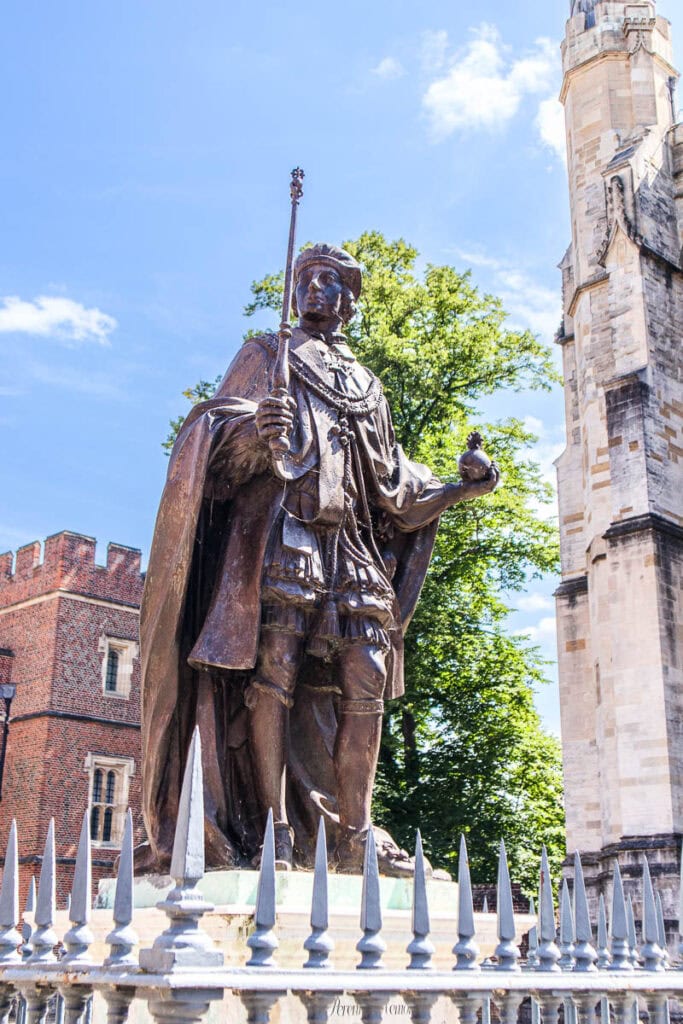
What is a King’s Scholar?
As mentioned, the historic college started with spaces for 70 King’s Scholars and other boys known as Oppidans (who paid for their accommodation or education), and this tradition has continued over the school’s 500 years. Even today, there is an allocation for 70 King’s Scholars to attend the school. Approximately 14 of these special scholarships are awarded annually.
To gain one of these prestigious places, boys have to pass a series of challenging entrance exams. If they’re accepted, they’ll live in College House and wear special gowns which indicate their status. They’ll also get to enjoy meals in the spectacular College Hall – like a real life Hogwarts!
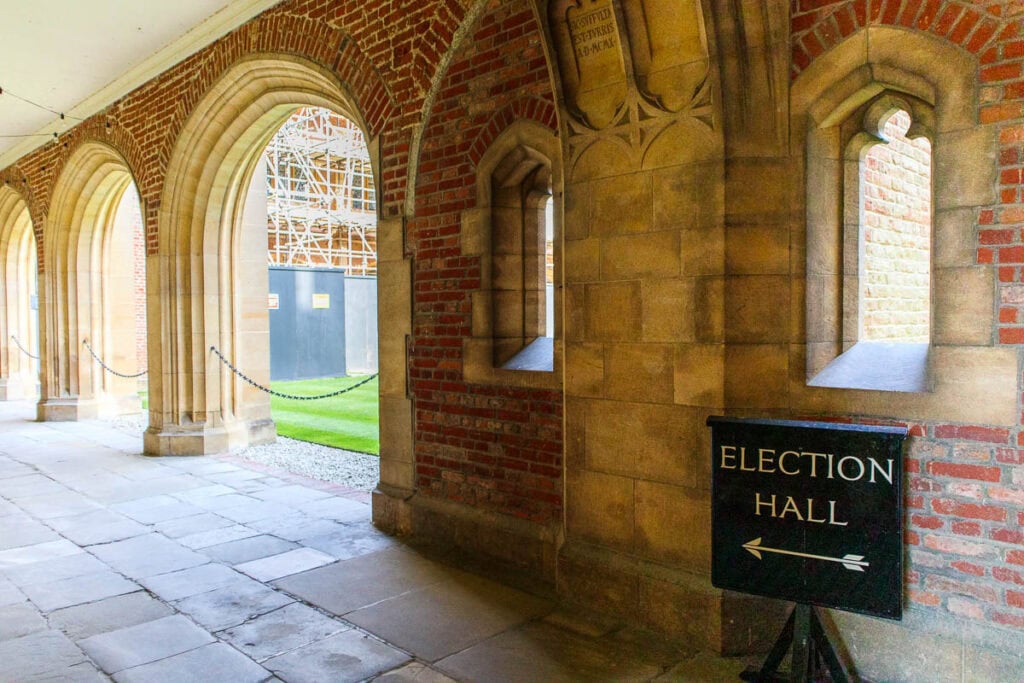
Teaching still takes place in medieval buildings
On the Eton College Heritage Tour you get to see inside the Lower School which dates back to the 1440s. This timber-framed medieval building was the college’s sole classroom for over 200 years.
I couldn’t quite believe that it was still used for lessons today! When you see it, you’ll be amazed by the history. The wooden desks are carved with messages and names, many done with penknives, which would have been carried by boys to sharpen their quills. There’s a rule today that every student has at least one lesson in this space during his time at the school.

The iconic Lupton’s Tower
One of the most iconic structures within Eton College is Lupton’s Tower. The pretty gatehouse dates back to the 1520s and has an ornate clock on the top. Many compare it to the architecture at Hampton Court Palace, which dates back to a similar time during the reign of Henry VIII.
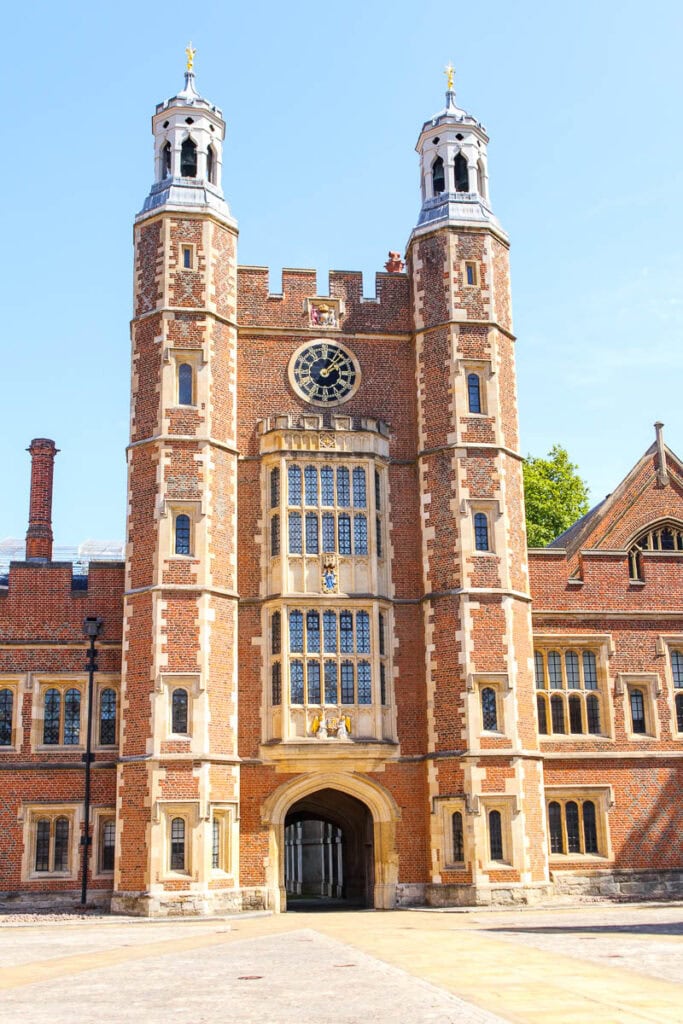
There are some interesting things to spot on the tower, most notably the Blessed Virgin Mary. Henry VIII enforced that Catholic symbols must be removed during the English Reformation, but this one survived. But how? Well, perhaps because you’ll see a flattering coat of arms dedicated to Henry VIII on a much higher level above it!
The clock on Lupton’s Tower has notoriously loud bells. I can vouch for that as I heard them chime several times during my tour of Eton! These days they switch them off in the evenings so as not to disturb the students.
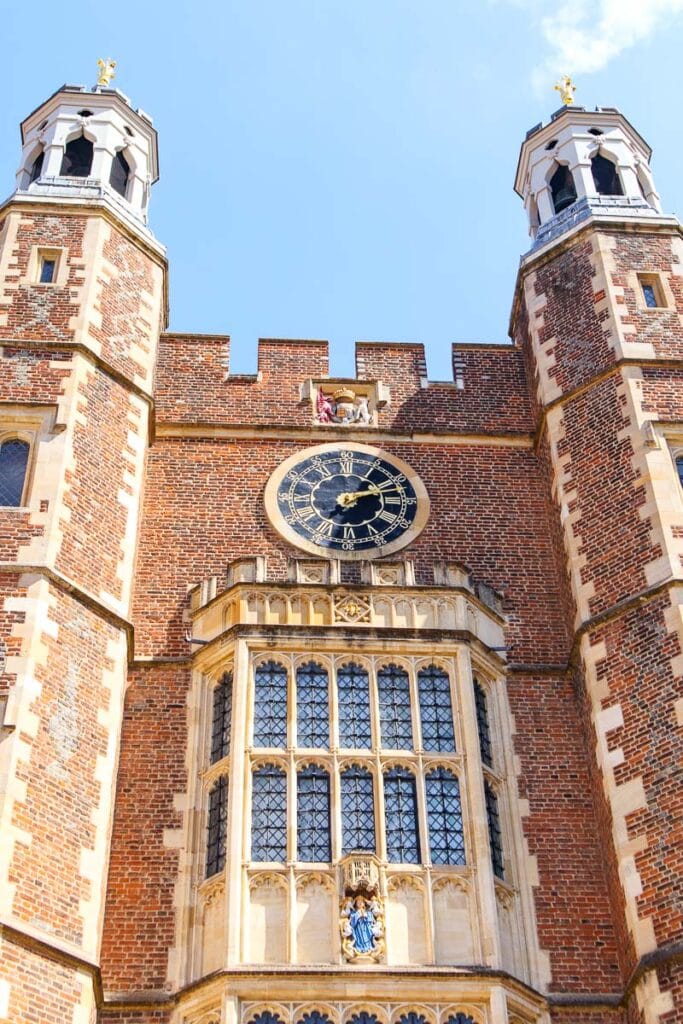
College Chapel hides some interesting secrets
Construction of the beautiful chapel started in 1441 and is a classic example of Gothic architecture with its stone vaulting and large stained glass windows. There are also some incredible medieval paintings around the choir stalls, dating back to the 1480s. They’re some of the best examples of medieval art still on view today.
However, all as not as it seems! These paintings were actually whitewashed in 1560 and subsequently forgotten about. They weren’t rediscovered until 1847, then restored in all their glory in 1923. What a discovery that must have been!
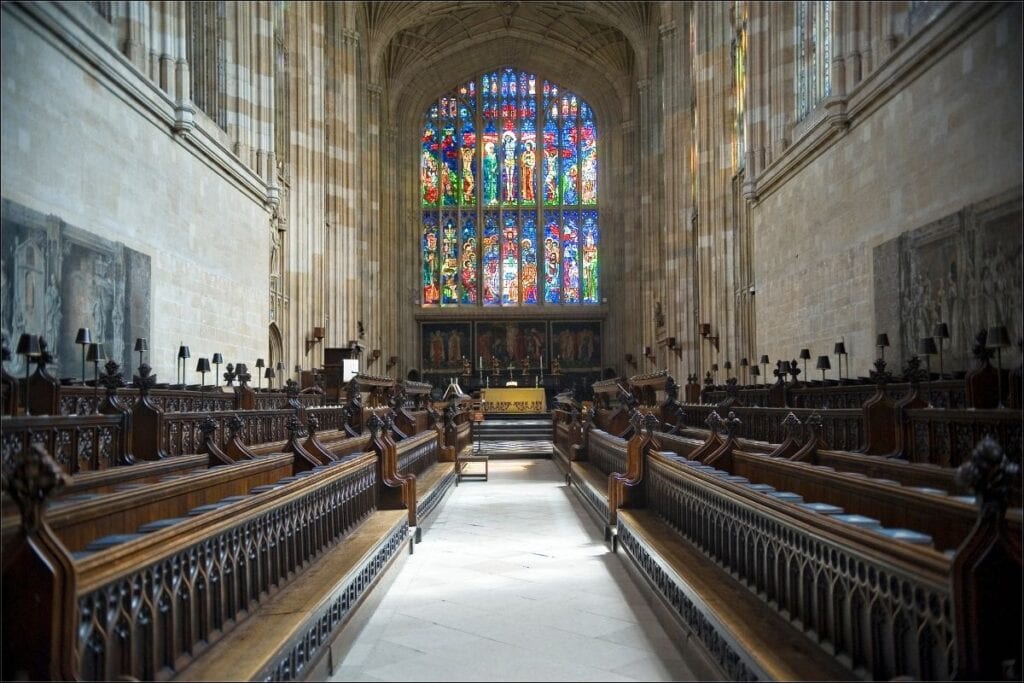
One of the oldest items in Eton?
If you visit College Chapel, take a look at the bronze lectern which holds the Holy Bible. It rotates, with the Old and New Testament on each side. It’s hard to believe, but this item dates back to 1475, and yes, it’s still in use today!
Eton College Chapel is still used every day
Back in the 1440s when the chapel was constructed, there would have been 14 services every day. These days, around half the school use it, with over 500 students worshipping each morning at 8.40am, before their lessons start at 9am.

The Eton uniform has changed over time
I couldn’t share these fascinating facts about Eton without talking about the iconic uniform. When you see school boys wandering around Eton, you’ll notice their smart attire, usually dressed in pinstripe trousers, white shirts, black tailcoats and a waistcoat. But, did you know it used to be a lot more vibrant?
There are paintings from the 18th century which show boys wearing blue coats with red collars, and other bright shades. For the first part of the 19th century students mainly wore blue cloth coats and yellow waistcoats. Back then, coloured dyes were expensive so it may have been a way to show wealth. From the 1850s, the famous top hats came in as, but they were removed by 1948 after the Second World War.
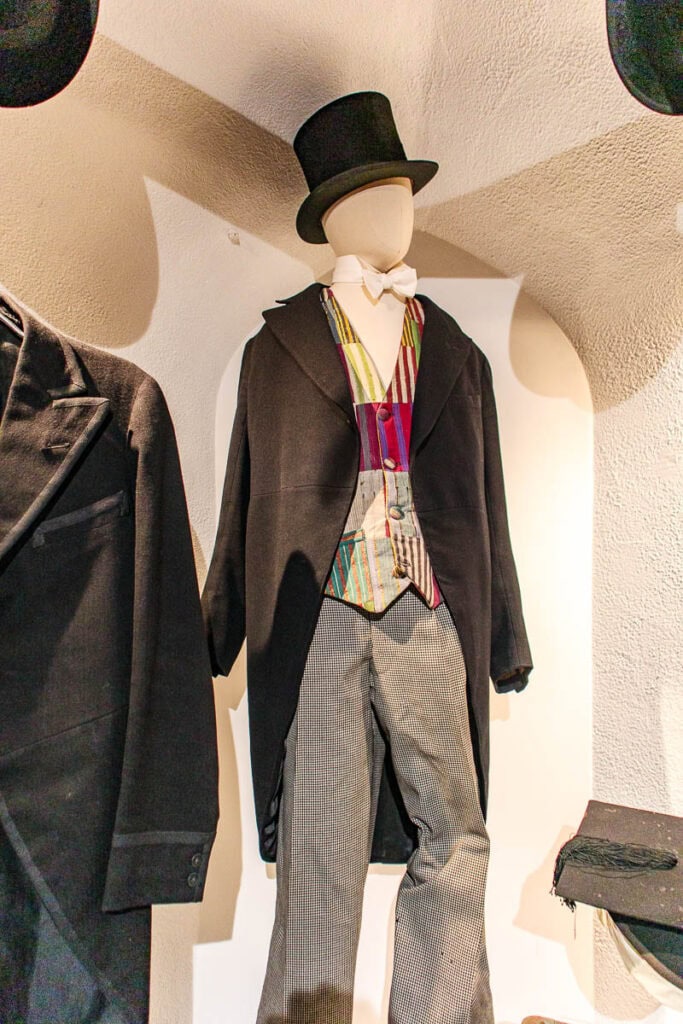
An official list of dress regulations was introduced in 1964, which is what you’ll see most students wearing today. This comprises:
- Black pinstripe trousers
- White collarless shirt – some earn the right to wear ‘stick ups’ which is a special type of collar
- The Eton tie (a thin strip of white cloth)
- Black waistcoat
- Black tailcoat
Most people purchase uniform from stores such as Welsh and Jeffries Eton and Billings & Edmonds, which are located on Eton High Street.

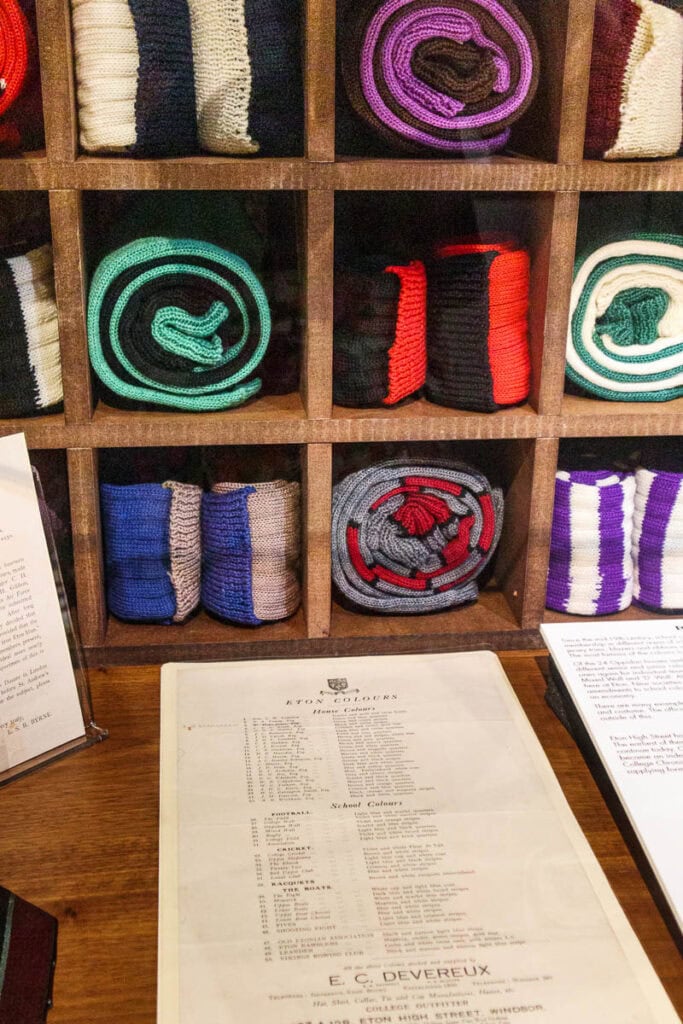
Eton has many Houses
Other than the King’s Scholars, all other boys (Oppidans if you remember the name) live in one of 24 boarding houses. These are dotted throughout the area, with names such as Baldwin’s Bec, Farrer House and The Timbralls. There are approximately 50 boys in each, with a House Master in charge, assisted by a Matron or Dame (female role). They look after the welfare of the boys living there.
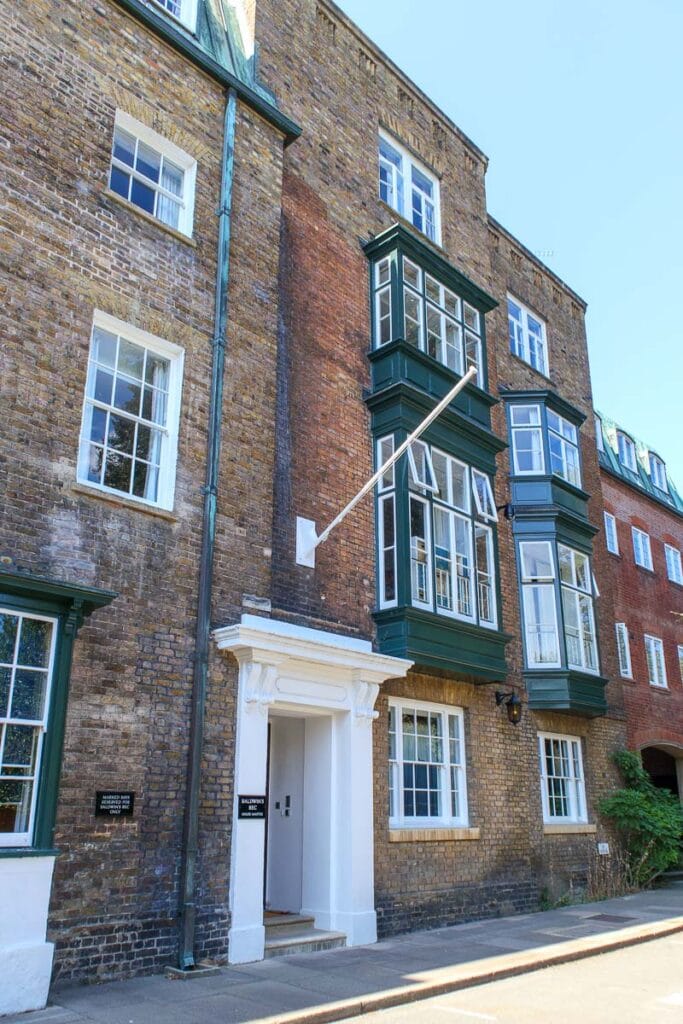
Girls attended Eton for a short time
There was a trial in the 1980s where a few girls were chosen to attend the school, in preparation for applying to Oxford or Cambridge University. There were also a few House Master’s daughters, such as Emily Bourne, who were allowed to attend the college. The trials were brief, and it’s now back to being a school just for boys.
Eton College is home to some unique sports
Have you heard of Eton Fives or The Wall Game? These are both Eton sporting specialities, with interesting histories!
Eton Fives is a fast-paced game played with a small cork ball, which you hit against the walls of a three-sided court. The court is modelled on the base of the chapel steps, where it was first invented. This game has travelled a bit, and is played around the world.
The Wall Game is literally played up against the school wall that runs along Slough Road. It’s got elements similar to football and rugby, and is played on St Andrew’s Day and Ascension Day. This game is pretty niche, so you won’t hear of it being played outside of Eton.
Boarding only
Around 1,350 boys attend Eton College, and all of them are full boarders, living in one of the school’s numerous houses scattered throughout the town. There are no day pupils, which gives the school a unique, immersive atmosphere where school life extends beyond the classroom.
A pivot during the pandemic
The school opened its doors to key workers and their children during the COVID-19 pandemic, when regular pupils were sent home. Some key workers stayed in the boarding houses, such as ICU nurses, police, paramedics and midwives, who couldn’t live at home due to vulnerable family members.
School classrooms were used to teach children and the school’s sports pitches and gardens were also offered to those in need. The school’s kitchens even prepared meals each day.
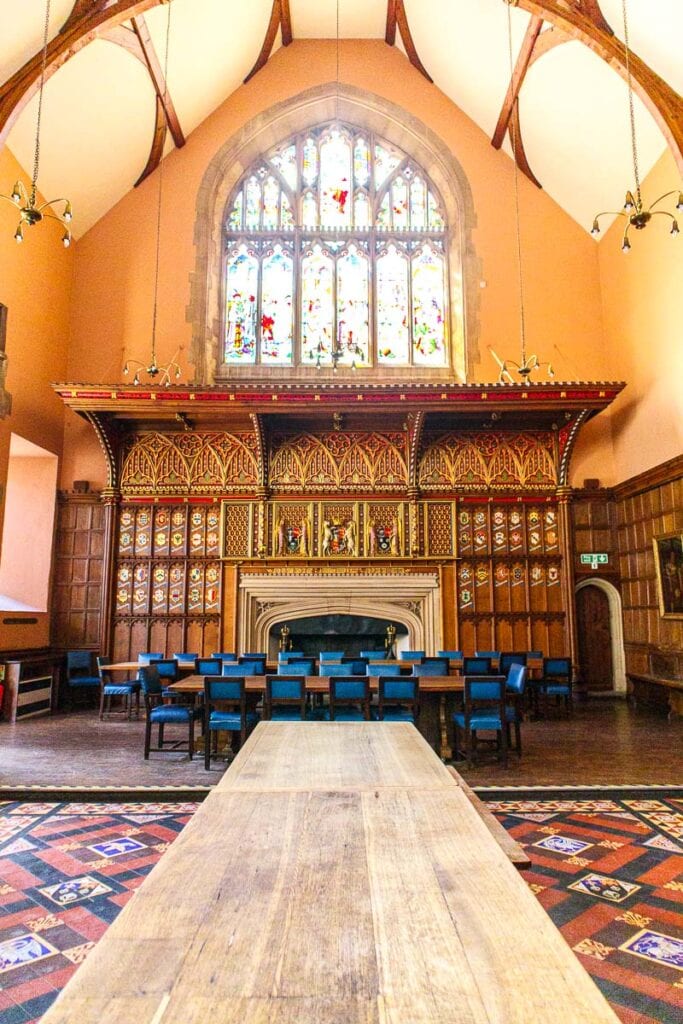
Famous on film
Eton College has provided the location for some huge blockbusters. In Chariots of Fire, the college’s cloisters and quadrangles doubled as Trinity College, after filming permission was denied by Cambridge.
Also, do you remember the scene in Shakespeare in Love where Colin Firth and Gwyneth Paltrow descend the church steps after their wedding? That was actually shot on the steps of College Chapel.
Plus, the College Hall was used for scenes in The Madness of King George in 1994.
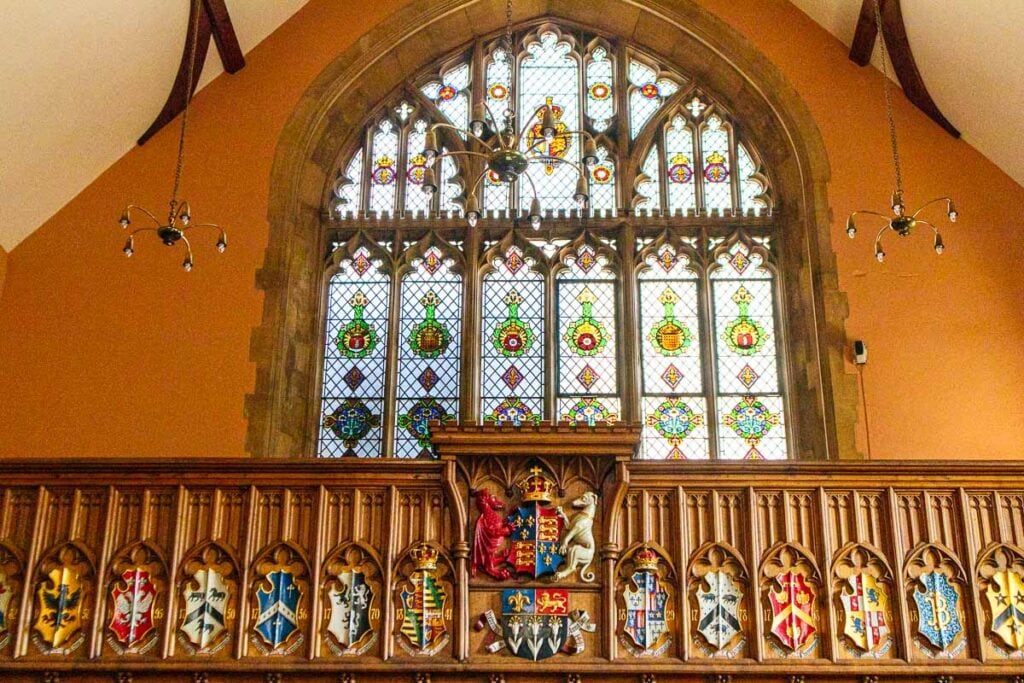
A mini dictionary of Eton
It feels like there’s a whole vocabulary that goes along with this school. Here are a few phrases and nicknames you might not be familiar with:
- Provost – The Chairman of Eton College’s governing body… essentially in charge of the school.
- Beak – A teacher or master.
- Dame – The matron of a boarding house, responsible for boys’ day-to-day welfare.
- Dry Bob – A boy who plays cricket.
- Wet Bob – A boy who rows.
- Slack Bob – A boy who does not play sport or a boy who is neither a Dry Bob nor a Wet Bob.
- Pop – A select group of senior prefects; the name is short for “The Eton Society.” They wear flamboyant waistcoats of their own choosing.
- Sock – A prefect in one of the boarding houses.
- Tardy book – The register signed if a boy is late for a lesson.
- Election – The process of selecting new King’s Scholars.
- Div – A lesson.
- Half – A school term, even though there are three ‘halves’ in school year!
- Trials – End of term exams
- Stick-ups – A wing collar with white bow tie worn by senior boys who have excelled in various areas.
- Chambers – A break period between lessons in the morning.
- Keeper – A captain of a sport or activity.
- Lock up – The time when boys have to be back in their Houses at night.
Eton’s most famous students
Eton’s alumni is impressive, covering careers in politics, literature, acting, sport and, of course, royalty. Here are some of the most famous Old Etonians:
Royal Family
- Prince William, Prince of Wales – Heir to the British throne
- Prince Harry, Duke of Sussex – Younger son of King Charles III
- Prince Andrew, Duke of York – Second son of Queen Elizabeth II
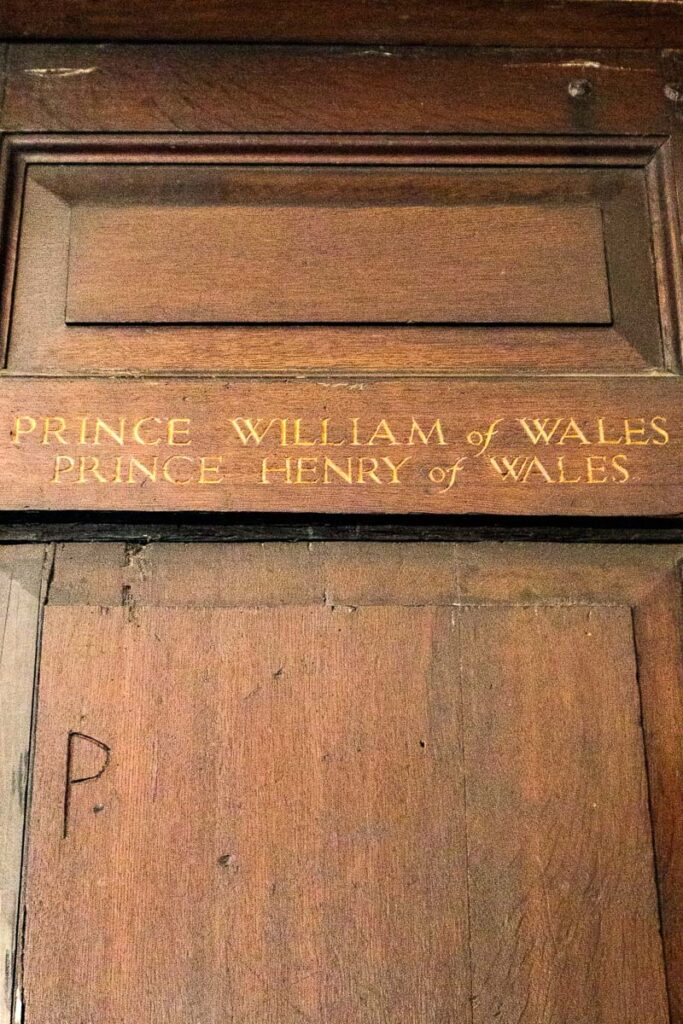
British Prime Ministers
Eton College has educated 20 British Prime Ministers. That’s more than any other school in the UK. Here are a few of the famous names:
- Boris Johnson – Former UK Prime Minister (2019–2022)
- David Cameron – Former UK Prime Minister (2010–2016)
- Harold Macmillan – UK Prime Minister (1957–1963)
- Anthony Eden – UK Prime Minister (1955–1957)
- William Gladstone – Four-time UK Prime Minister in the 19th century
- Robert Walpole – Often regarded as Britain’s first Prime Minister (1721–1742)
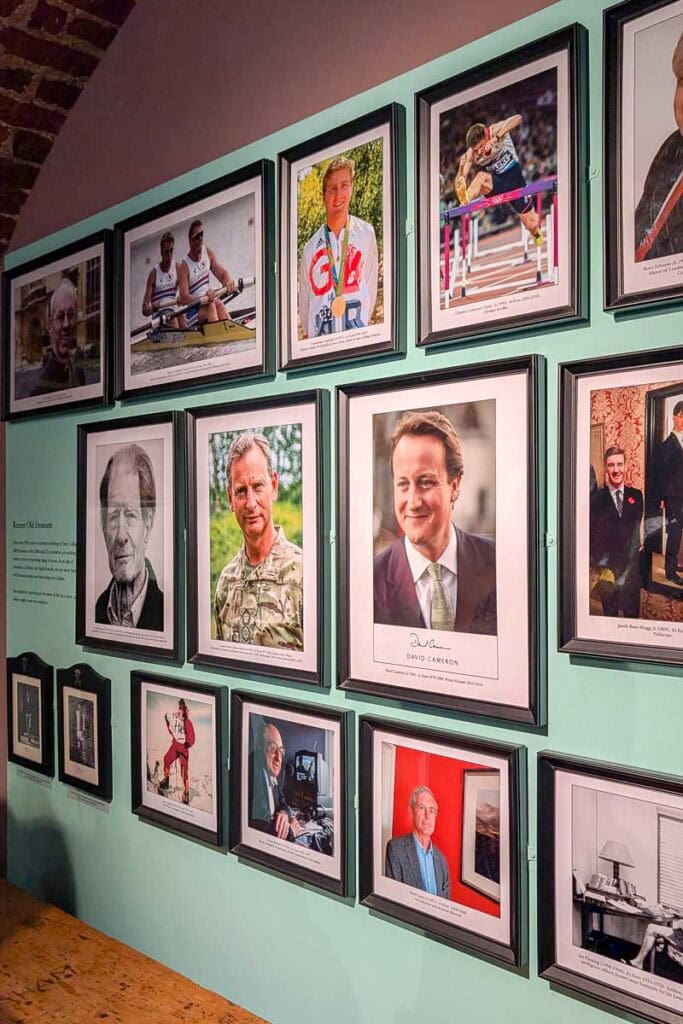
Writers & Poets
- George Orwell – Author of 1984 and Animal Farm
- Aldous Huxley – Author of Braeve New World
- Thomas Gray – Poet of Elegy Written in a Country Churchyard
Actors & Performers
- Hugh Laurie – Actor (House, Blackadder)
- Eddie Redmayne – Oscar-winning actor (The Theory of Everything)
- Damian Lewis – Actor (Homeland, Band of Brothers)
- Tom Hiddleston – Actor (Loki, The Night Manager)
- Bear Grylls – Adventurer and TV presenter (Man vs. Wild)
Sportsmen
- George Harris – England cricket captain (1896–1899)
- Matthew Pinsent – Four-time Olympic gold medallist in rowing
- Jamie Spencer – Champion jockey
How to get into Eton College
Entry to Eton is via a long process of applications and exams. Most boys need to register sometime before the end of the academic year he turns 10 (year 5). After this the only potential routes of entry will be through scholarships or sixth form entry.
After registering, boys are invited to take part in a Stage 1 exam. These are ISEB Common Pre-Tests, which feature multiple choice questions, covering verbal reasoning, non-verbal reasoning, English and maths. They also need to provide a report by their current headteacher. Depending on results, some will be invited to Stage 2, which includes an interview and an online test.
After this, conditional places are offered, so long as boys pass the King’s Scholarship, Common Entrance or Eton Entrance exams in year 8.
The only exceptions are the King’s Scholars, of which there are around 14 per year. These are for exceptional academics and requires passing a challenging set of exams in English, creative writing, maths A, science and a general paper. They must also choose three optional exams from French, Latin, Greek, maths B, general II and history-geography-divinity).
If accepted, most boys start at the school in year 9, when they turn 13 years old. They graduate at the age of 18.
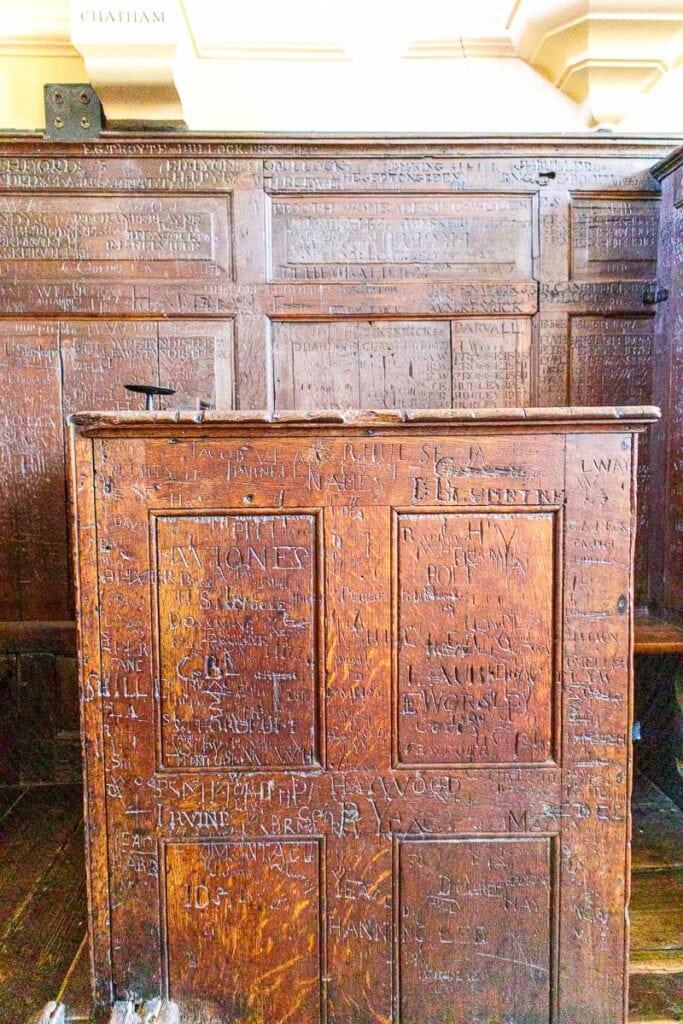
The price is high
Everyone knows it costs a lot to attend Eton College. According to the website, from January 2025 the total fees were £21,099.60 per term. As there are three terms, that’s a total cost of 363,298.80 (including VAT) per academic year.
There are some bursaries and scholarships available each year. Approximately 18% of boys receive financial support towards their fees (averaging a 71% award), and around 100 boys pay no fees.
Contrary to popular belief, it’s not the most expensive independent school in the UK.
So, did any of these facts about Eton College surprise you? School life may have changed a little over its 500 years of history, but it’s amazing how many of its traditions live on.
If you’re interested in learning more about the famous school, I’d recommend visiting the Museum of Eton Life or booking a place on an Eton College Heritage Tour.


